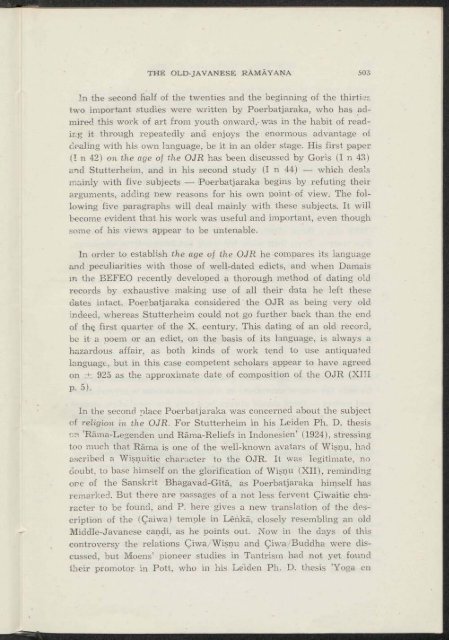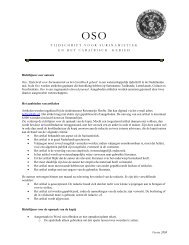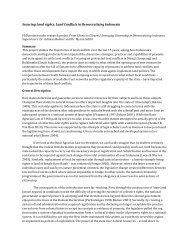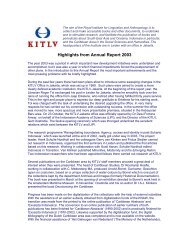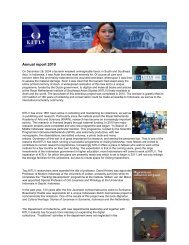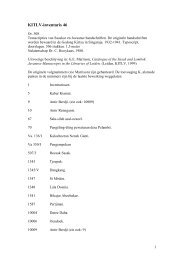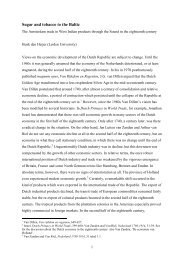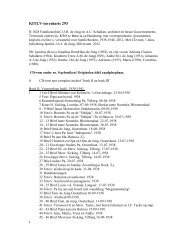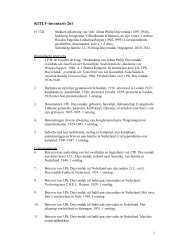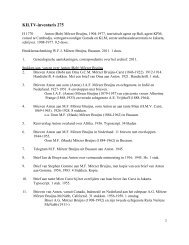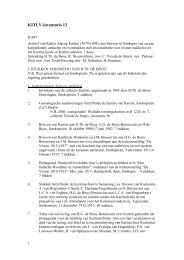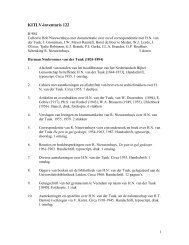ILMU BAHASA, ILMU BUMI KEBUDAJAAN INDONESIA - kitlv
ILMU BAHASA, ILMU BUMI KEBUDAJAAN INDONESIA - kitlv
ILMU BAHASA, ILMU BUMI KEBUDAJAAN INDONESIA - kitlv
Create successful ePaper yourself
Turn your PDF publications into a flip-book with our unique Google optimized e-Paper software.
THE OLD-JAVANESE RÂMAYANA 503<br />
In the second half of the twenties and the beginning of the thirties.<br />
two important studies were written by Poerbatjaraka, who has admired<br />
this work of art from youth onward,- was in the habit of reading<br />
it through repeatedly and enjoys the enormous advantage of<br />
coaling with his own language, be it in an older stage. His first paper<br />
(I n 42) on the age of the OJR has been discussed by Goris (I n 43)<br />
and Stutterheim, and in his second study (I n 44) — which deals<br />
mainly with five subjects — Poerbatjaraka begins by refuting their<br />
arguments, adding new reasons for his own point of view. The following<br />
five paragraphs will deal mainly with these subjects. It. will<br />
become evident that his work was useful and important, even though<br />
some of his views appear to be untenable.<br />
In order to establish the age of the OJR he compares its language<br />
and peculiarities with those of well-dated edicts, and when Damais<br />
m the BEFEO recently developed a thorough method of dating old<br />
records by exhaustive making use of all their data he left these<br />
dates intact. Poerbatjaraka considered the OJR as being very old<br />
indeed, whereas Stutterheim could not go further back than the end<br />
of the. first quarter of the X. century. This dating of an old record,<br />
be it- a poem or an edict, on the basis of its language, is always a<br />
hazardous affair, as both kinds of work tend to use antiquated<br />
language, but in this case competent scholars appear to have agreed<br />
on ± 925 as the approximate date of composition of the OJR (XIII<br />
p. 5).<br />
In the second place Poerbatjaraka was concerned about the subject<br />
of religion in the OJR. For Stutterheim in his Leiden Ph. D. thesis<br />
on 'Räma-Legenden und Räma-Reliefs in Indonesien' (1924), stressing<br />
too much that Râma is one of the well-known avatars of Wisnu, had<br />
ascribed a Wisnuitic character to the OJR. It was legitimate, no<br />
doubt, to base himself on the glorification of Wisnu (XII), reminding<br />
one of the Sanskrit Bhagavad-Gîtâ, as Poerbatjaraka himself has<br />
remarked. But there are passages of a not less fervent Çiwaitic character<br />
to be found, and P. here gives a new translation of the description<br />
of the (Çaiwa) temple in Lehkä, closely resembling an old.<br />
Middle-Javanese candi, as he points out. Now in the days of this<br />
controversy the relations Çiwa/Wisnu and Çiwa Buddha were discussed,<br />
but Moens' pioneer studies in Tantrism had not yet found<br />
their promotor in Pott, who in his Leiden Ph. D. thesis 'Yoga en


